I can’t get enough of chimichurri.
After trying it for the first time in an Argentinian restaurant more than 20 years ago, I found myself slathering the tangy condiment on nearly everything I ordered, from bread to potatoes, churrasco to empanadas.
I started buying my favorite version of it from a local carnicería and for years I ate the bottled stuff, even though it’s silly easy to make.
Now that I have a garden where I grow half the ingredients in this sauce, there’s no excuse not to make my own chimichurri.
Every Argentine I’ve met has his own way of making it—whether it’s flat-leaf parsley or curly parsley, hand-chopped or food-processed. Sometimes there’s a fresh chile added. Sometimes a spoonful of shallots.
But however it’s concocted, one thing is for certain: The stars of this sauce are parsley and garlic.
Chimichurri has been bastardized a number of ways in American cuisine, even so far as being called “Argentinian pesto” or the “ketchup of Argentina”—which any Argentine will adamantly tell you is not true.
But this recipe is pure, authentic Argentina.
(Actually, authentic chimichurri uses dried oregano, but fresh herbs are too good for me to pass up.)
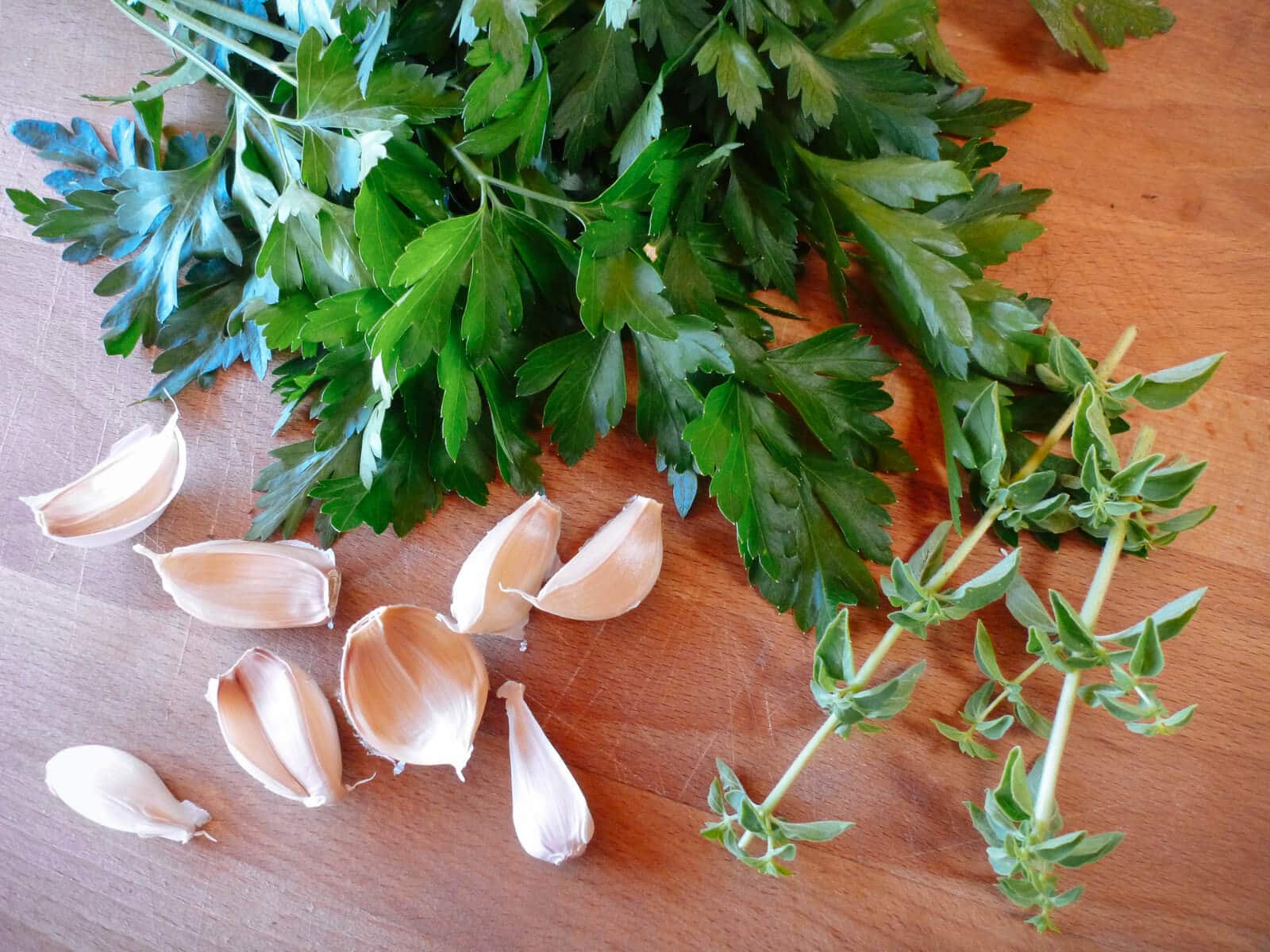
The bold, garlicky sauce famous to the Land of Silver is traditionally drizzled over meats in Argentinian asado (barbecue) and is sometimes used as a marinade.
I also like to spread it over roasted vegetables and mashed potatoes, mix it into homemade vinaigrette, or serve it as a dipping sauce for bread.
After you make yourself a jar from my chimichurri recipe, you’ll find plenty of other uses for it, too.
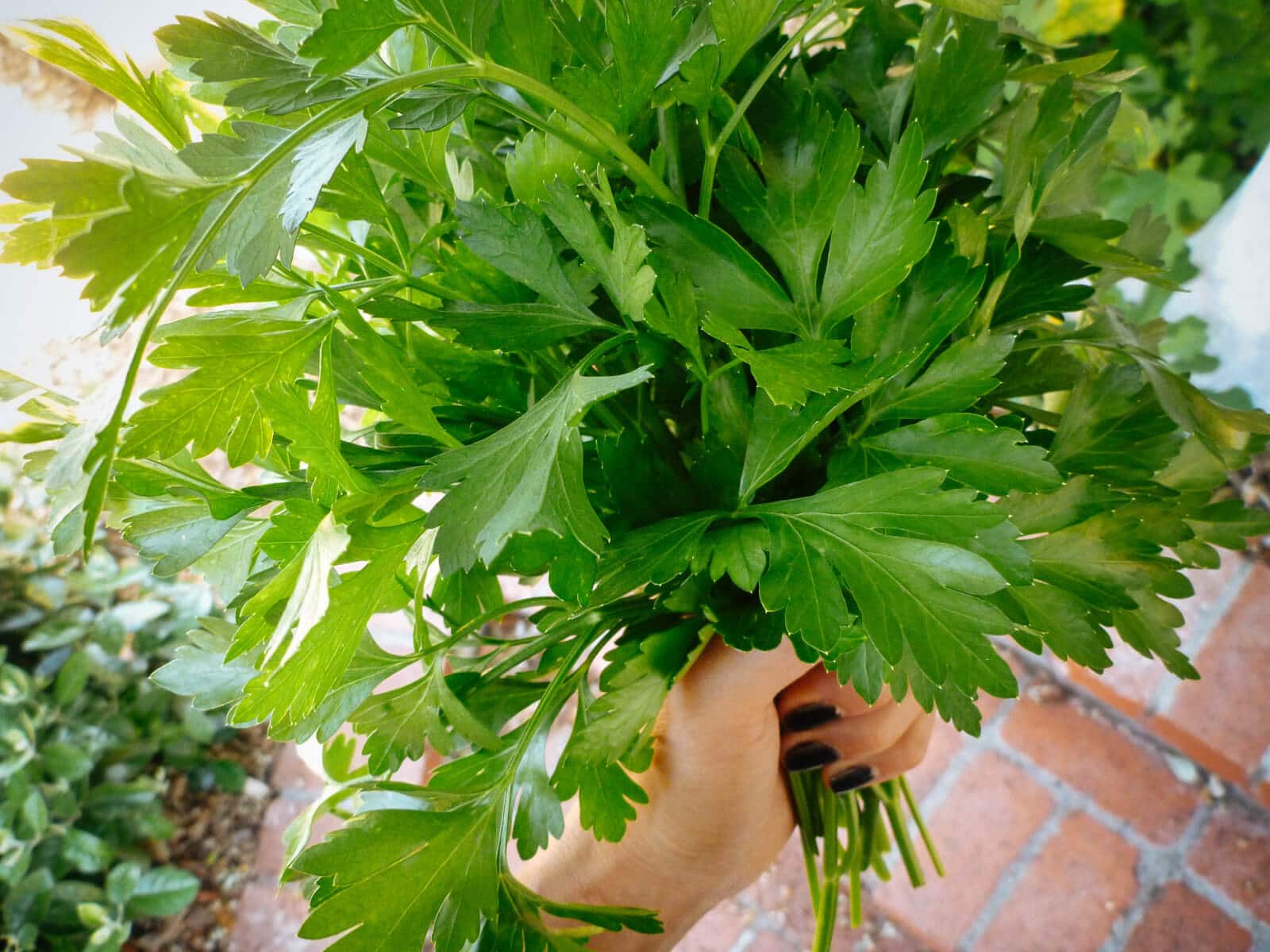
Chimichurri
Makes 2 cups
Ingredients
2 cups packed parsley, minced
3 tablespoons minced garlic
3 tablespoons minced oregano
1 1/2 tablespoons red pepper flakes
1/4 cup red wine vinegar
1 to 1 1/4 cups extra virgin olive oil
Making Chimichurri
I like to use my Italian Giant parsley for making chimichurri. The sprigs are huge and the leaves are so easy to pull off the stems. Whichever parsley you use, make sure it’s the freshest you can find.
I chop everything by hand as I like a chunky texture, but you can also add the fresh herbs to a food processor, pulse until fine, then add the red pepper flakes, red wine vinegar, and olive oil.
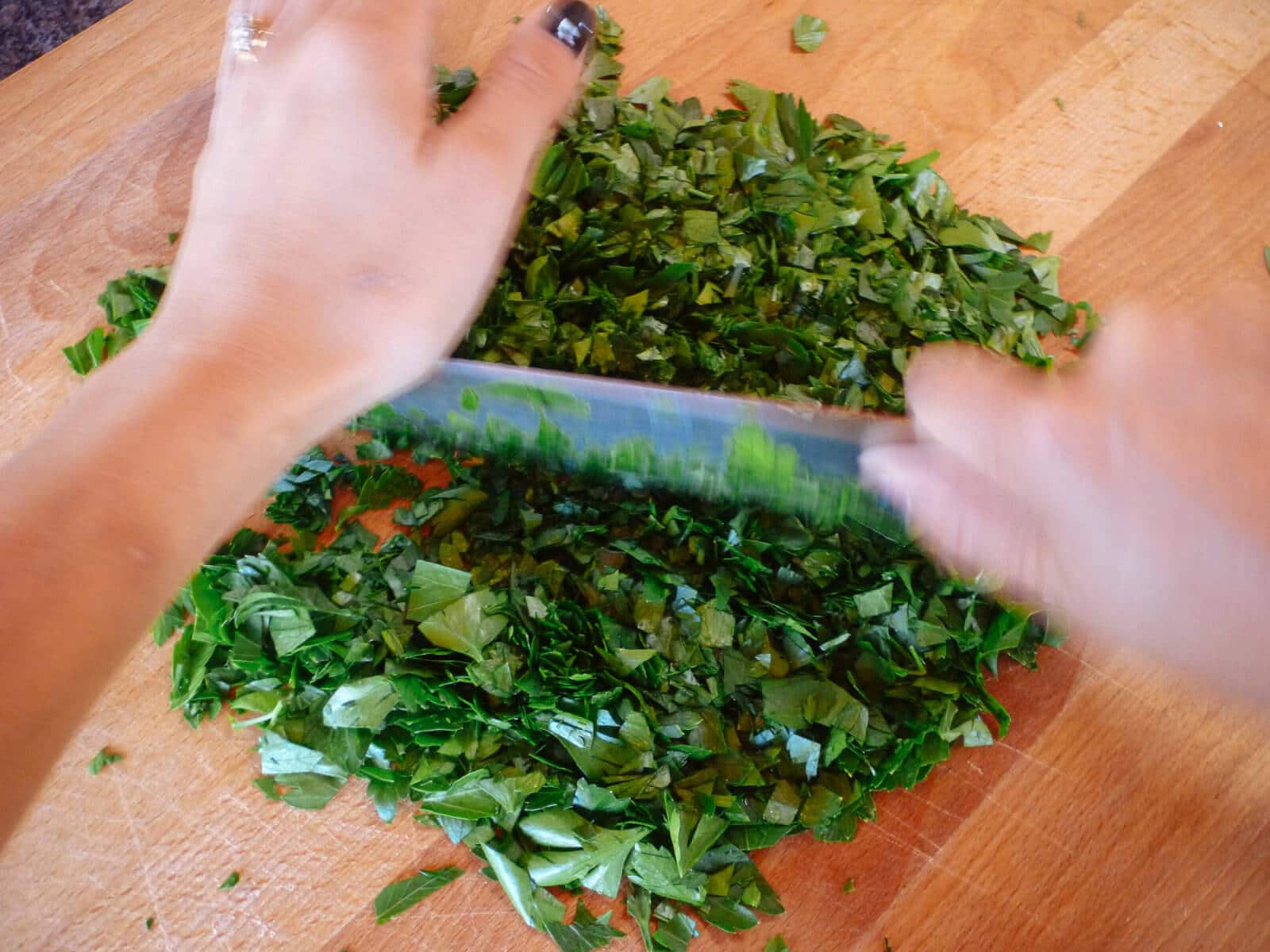
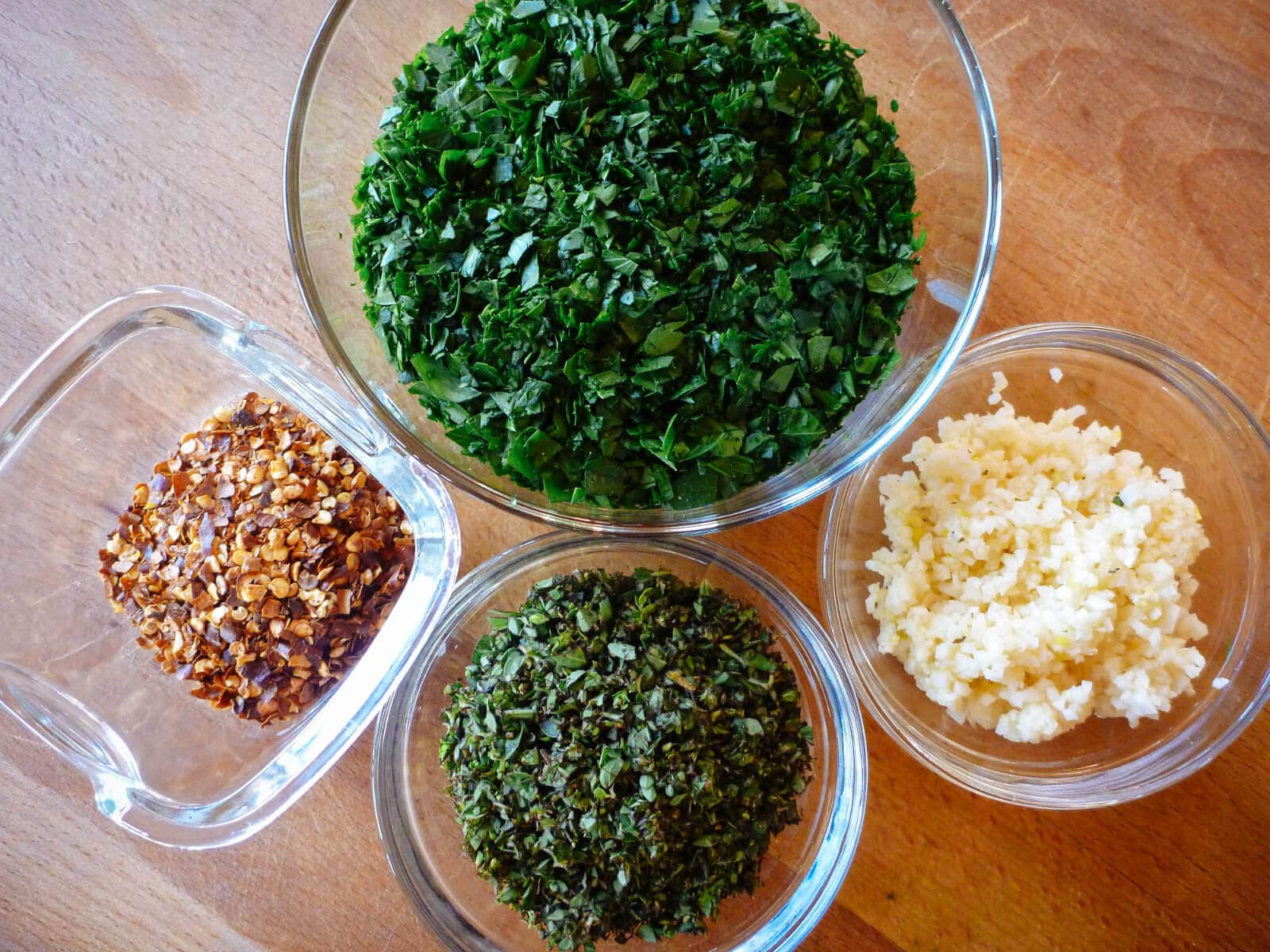
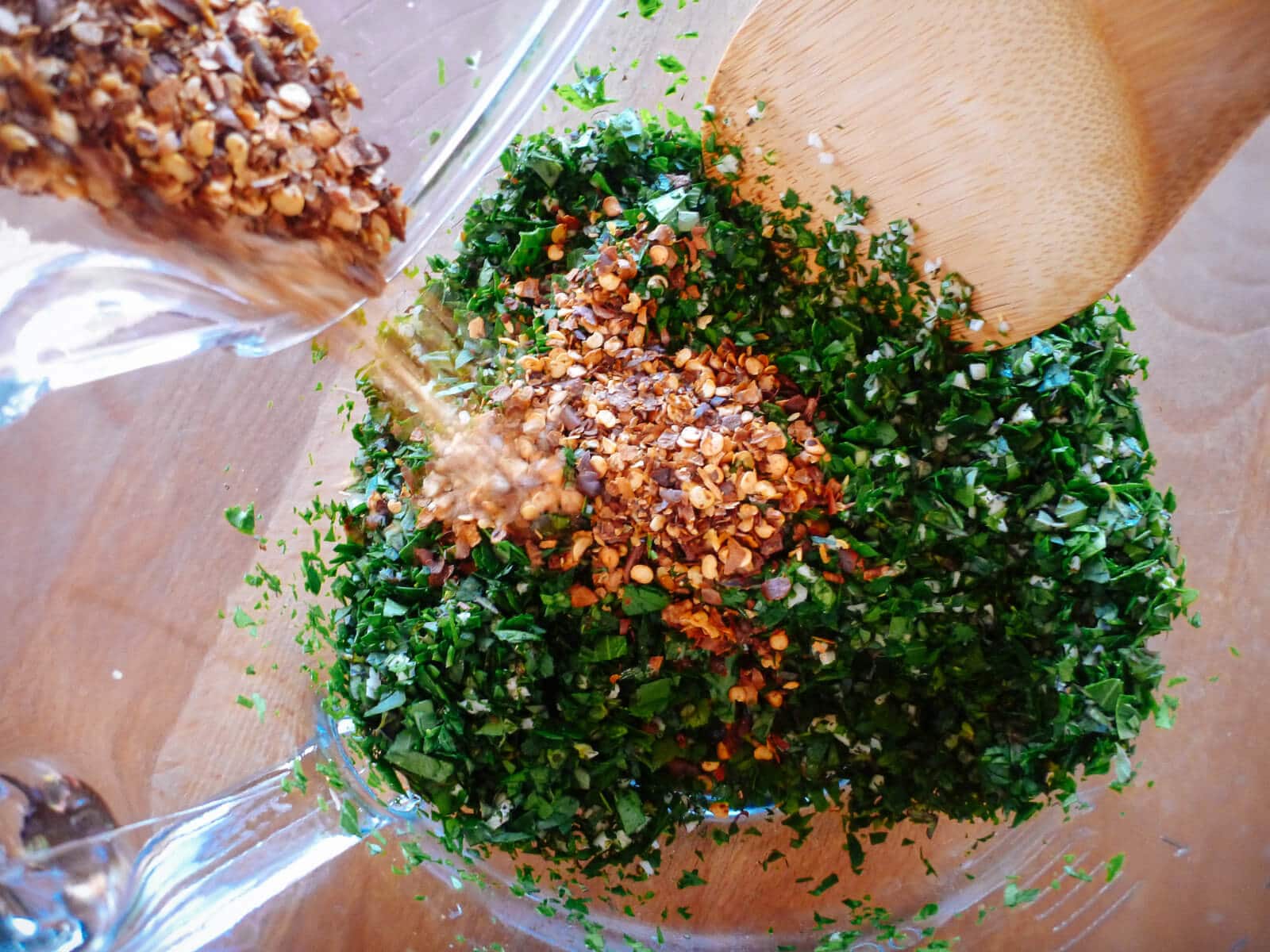
Use more or less olive oil as needed, depending on how much parsley you end up with. Stir all the ingredients together until well blended.
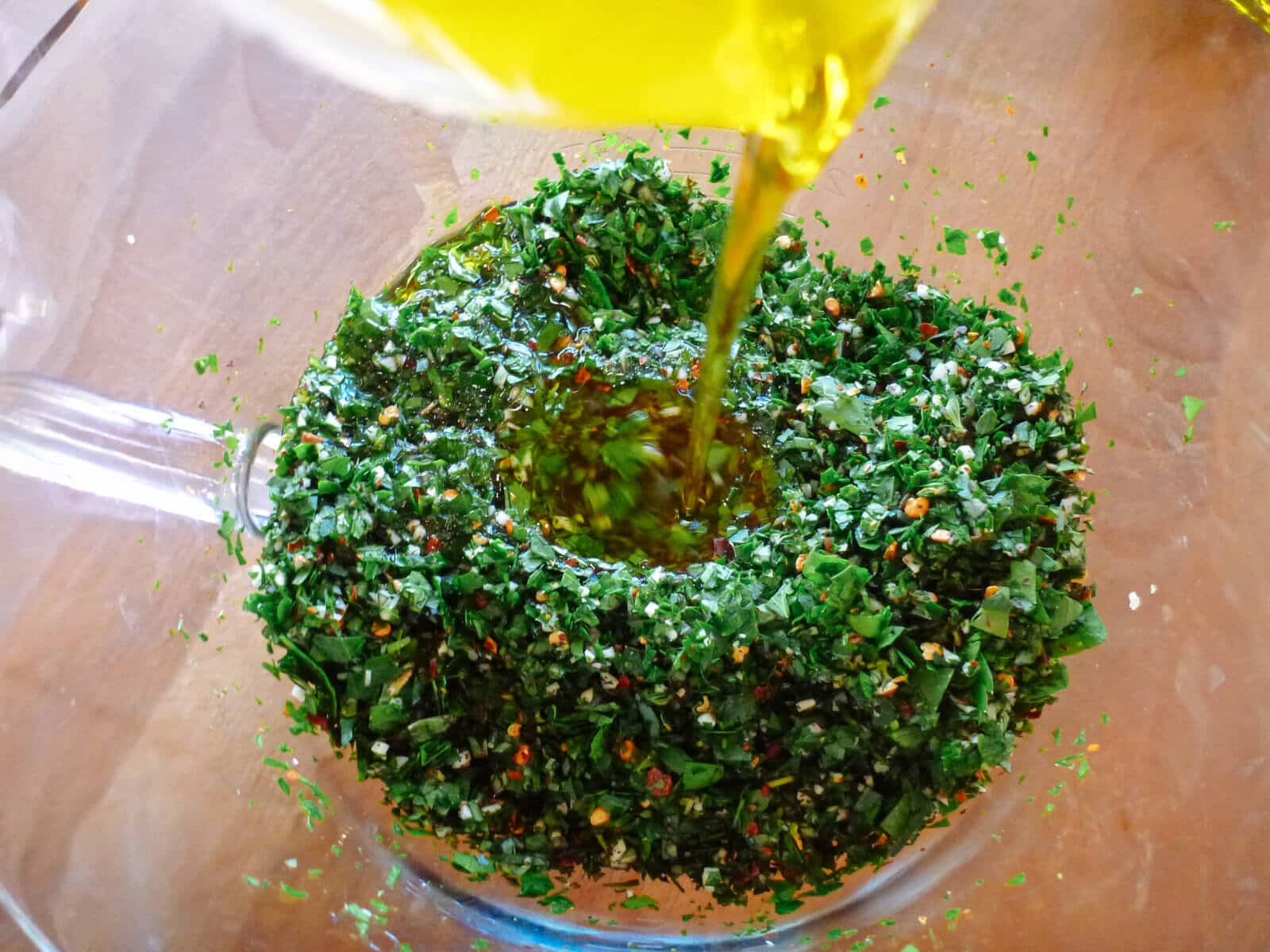
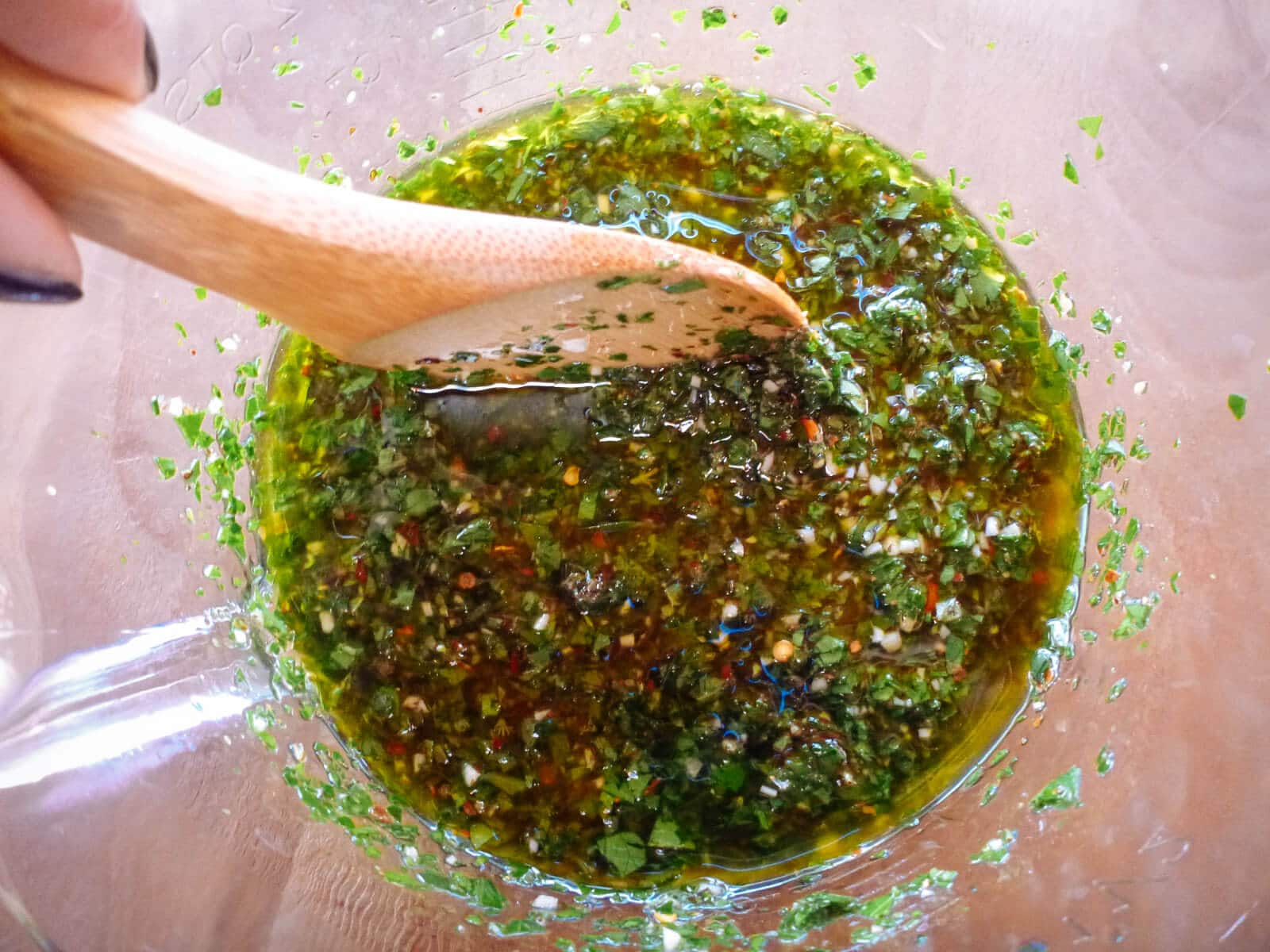
Decant the sauce into your container of choice and cover with a lid.
Let the chimichurri do its thing overnight, out on the counter, as the flavor will intensify the longer it sits.
Perfectly aged chimichurri is a deep army green and I’ve been known to squirrel away a jar for a week or more before I even open it.
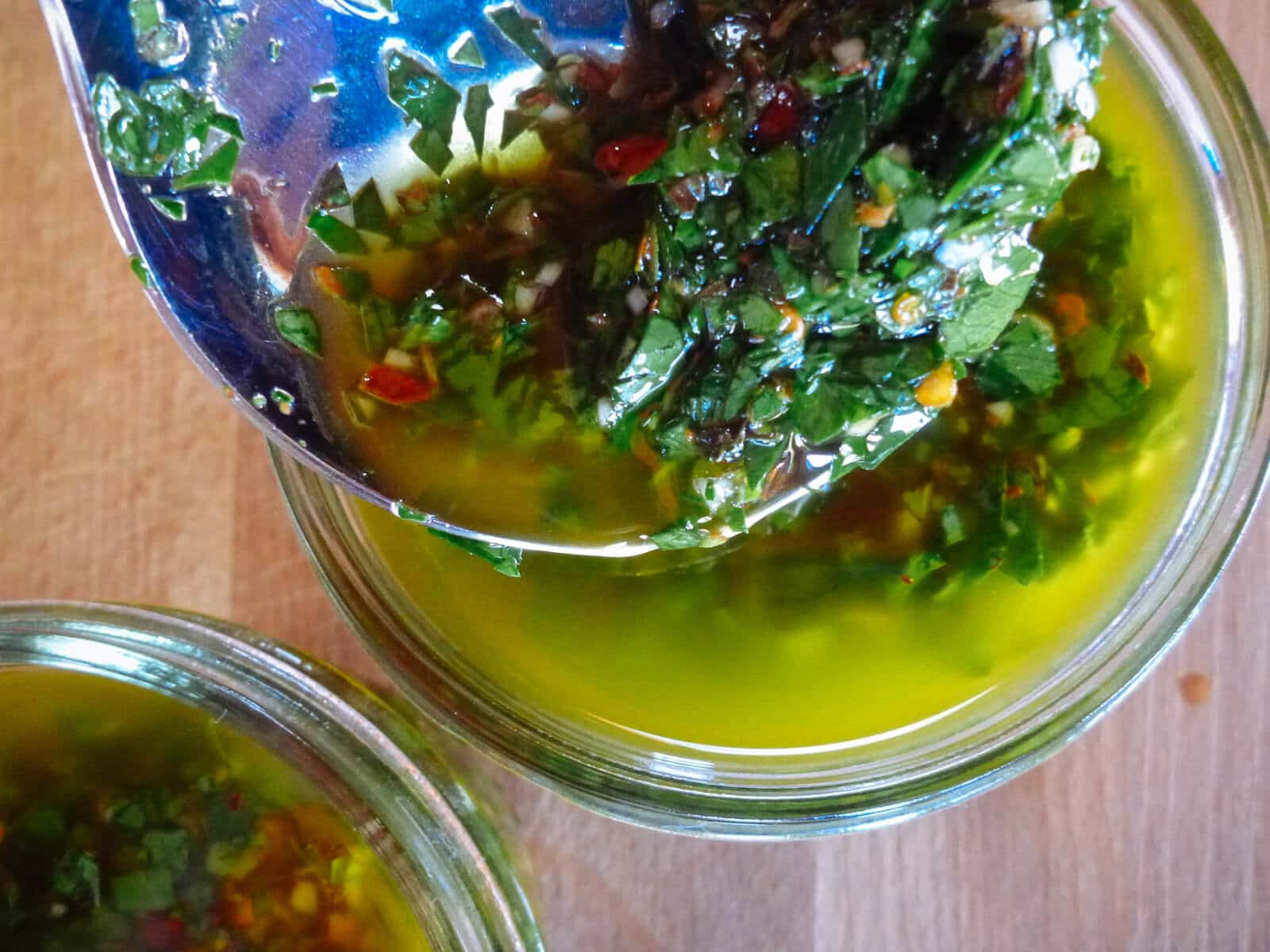
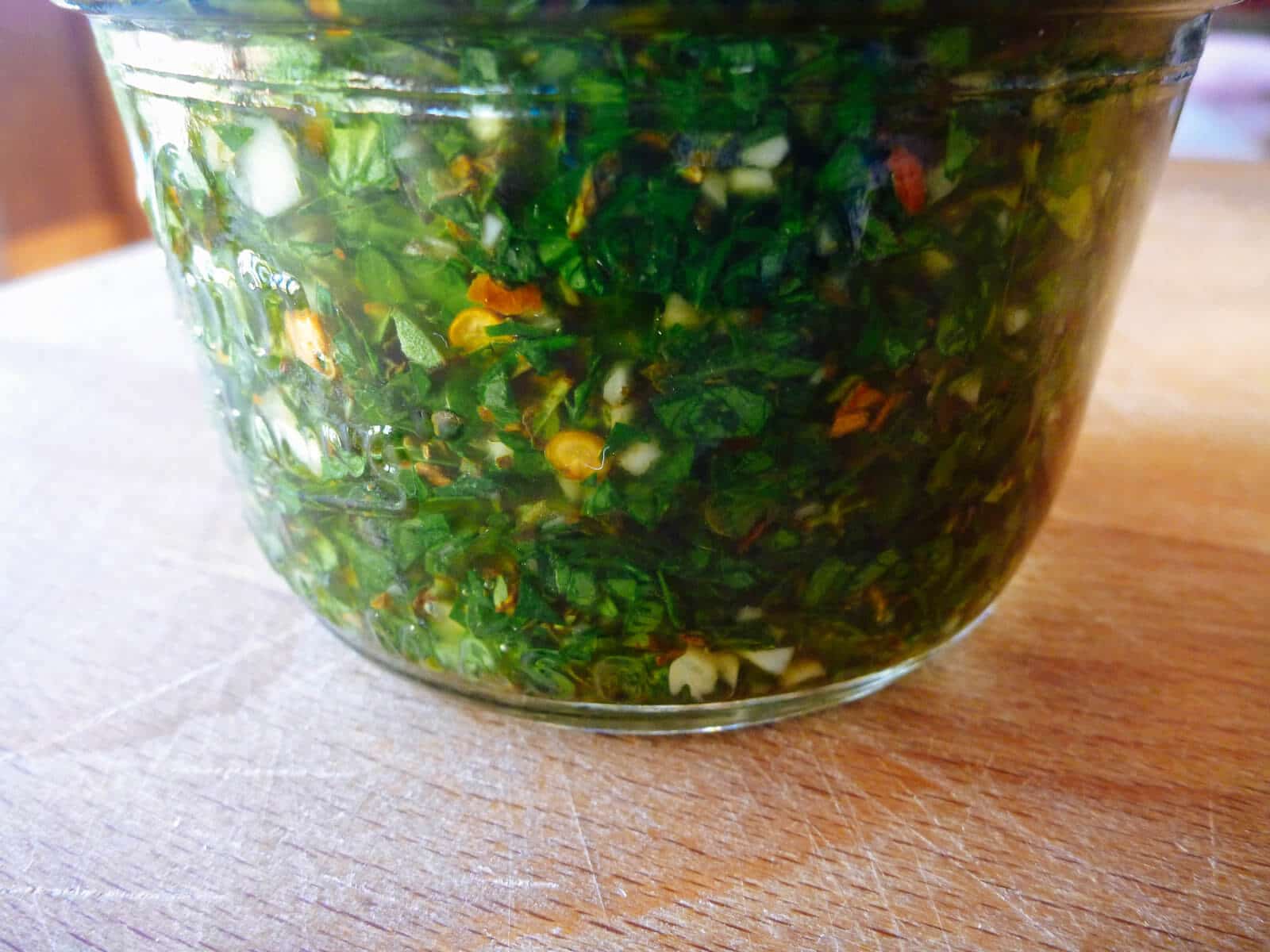
My favorite has always been the sauce that sits in a metal tin on the table at an Argentinian restaurant, all brown and murky looking, and you have no idea how long it’s been there or when it was last refilled but it tastes amazing… That’s the look you’re trying to achieve here!
Chimichurri
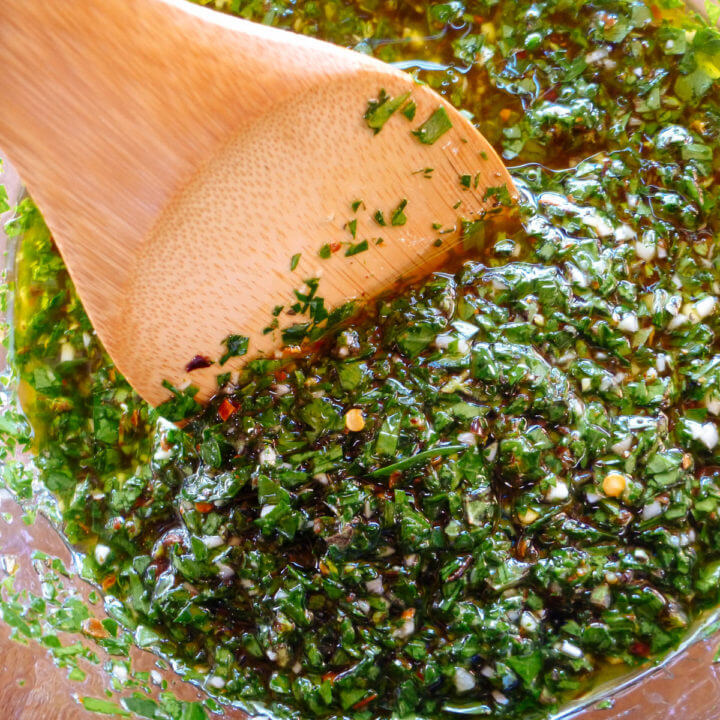
Chimichurri is often bastardized in American recipes, but this snappy, garlicky sauce is exactly what you'd find in Argentinian cooking and it tastes amazing!
Ingredients
- 2 cups packed parsley, minced
- 3 tablespoons minced garlic
- 3 tablespoons minced oregano
- 1 1/2 tablespoons red pepper flakes
- 1/4 cup red wine vinegar
- 1 to 1 1/4 cups extra virgin olive oil
Instructions
- In a medium bowl, combine the parsley, garlic, oregano, red pepper flakes, and red wine vinegar.
- Add just enough olive oil to make a chunky sauce that's not too thick and not too runny.
- Stir the ingredients until well blended.
- Decant the sauce into the container of your choice and cover with a lid.
- Let the chimichurri sit at room temperature overnight for the flavors to develop. The longer it sits out on the counter, the more the flavor intensifies. Refrigerate after 1 to 2 days. (The olive oil will congeal when chilled, but this doesn't affect the flavor or texture.) Bring the chimichurri to room temperature before using or serving.
Notes
Don't worry about trying to keep your chimichurri bright green and "fresh" looking.
My favorite chimichurri has always been the well-aged sauce that sits in a metal tin on the table at an Argentinian restaurant, all brown and murky looking, and you have no idea how long it's been there or when it was last refilled but it tastes amazing... That's the look you're trying to achieve here!
Recommended Products
As an Amazon Associate and member of other affiliate programs, I earn from qualifying purchases.
Nutrition Information:
Yield:
4Serving Size:
1/2 cupAmount Per Serving: Calories: 635Total Fat: 68gSaturated Fat: 9gTrans Fat: 0gUnsaturated Fat: 57gCholesterol: 0mgSodium: 22mgCarbohydrates: 7gFiber: 3gSugar: 1gProtein: 2g
Nutrition information isn’t always accurate.
This post updated from an article that originally appeared on April 3, 2013.
View the Web Story for authentic chimichurri recipe.


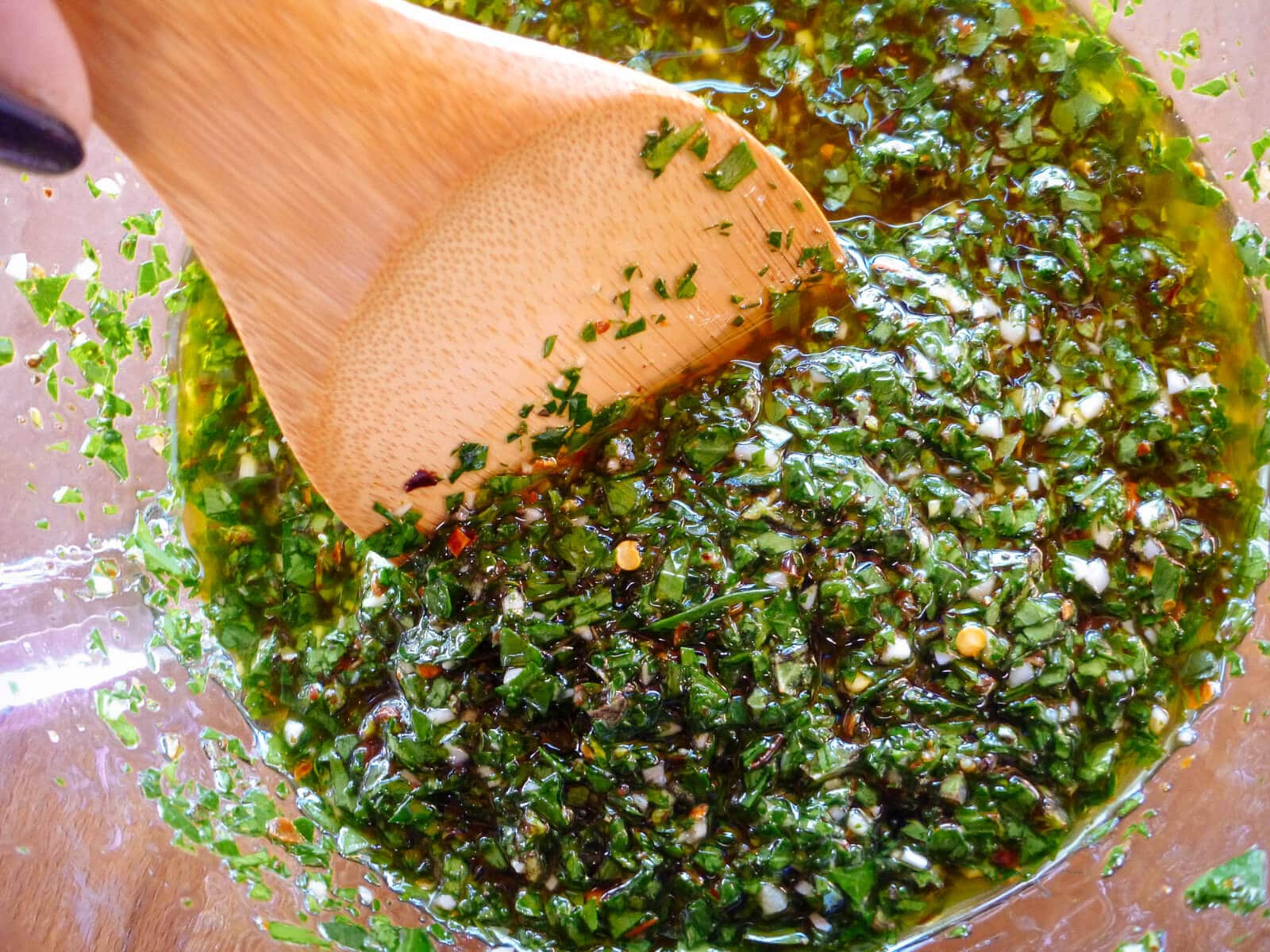















Hola. I am Argentinian and your recipe is perfect. I use a lighter oil but it really doesn’t make a big difference. For the comment that said that you should use dry ingredients that’s wrong. Yourr recipes is the same one we use to make witty my family every Sunday for our asados ( barbecues). The original chimichurri sauce is the one that you listed so thank you for keeping its original form. I get upset when restaurants call it chimichurri and add spices that we don’t even have in Argentina like cilantro , I guess I’m passionate about my country. Lol. Thank you.
It doesn’t surprise me that your chimichurri lasts as long as you need it to. With a quarter cup of red wine vinegar in it, the mix should be acid enough to pressure can the same way you do tomato sauce or to just let sit in the fridge until the jar is scraped clean. Thanks for the recipe. I’ll be making a batch up as soon as I get enough parsley. My garden is running a little low at present.
Hi Linda:
I liked this recipe so much I improved on it (at least in my mind), for my second batch. I substituted fresh lovage leaves, from my garden, for the parsley for a stronger, bolder green taste. Also for a stronger taste, I used Mexican oregano instead of the French or Italian varieties. Finally, I substituted Filipino sugar cane vinegar for the red wine vinegar. It has a much sharper bite.
I was delighted with the results, but your recipe provided me with a good starting point. Thanks so much.
I never would’ve thought of using lovage, and now I’m curious to try! So glad this recipe inspired something great in your kitchen!
I made this and found the dressing very mild.Used 2 red fresh chillies.So will work on spicing this up a bit more.
The flavor of chimichurri intensifies the longer it sits, so keep that in mind if you spice it up. 🙂
Thank you for posting this recipe, Linda. I am looking to preserve my herbs as the growing season is winding down. How long can Chimichurri be store for? Is it an over-the-winter kinda thing or do you make it and eat is? The recipe sounds delicious regardless of storage, and I am going to make it.
It keeps for quite a while, at least 2-3 months in the fridge in my experience (I’ve never had a jar sit longer than that, since we LOVE it!). You can also freeze chimichurri.
Nice try, but as you yourself pointed out real authentic chimichurri does not use fresh herbs, it needs to be dried, and it does not use olive oil. Basiclaly by using fresh ingredients you are just making a salsa verde (green sause) not chimichurri. A lot of people also use mint – WRONG – and olive oil – WRONG.
The first comment, from an Argentinian said they use olive oil and fresh herbs. Others who get their recipes from their native born parents always use fresh parsley, sometimes fresh oregano, sometimes dried. Dried parsley would have no taste or texture. It’s not salsa verde, which is made mainly from tomatillos. I agree not to use mint.
What do you mean by “decant”? Is there a special method of pouring the sauce or can you just mix it in the jar?
You can just pour the mixture into a jar. No special method to it! Just stir it up before you use it.
Hi, Linda. Thanks for the recipe. So there’s no need to add salt?
I’ve never added salt and don’t think the recipe needs it, but salt is a personal preference.
Just made this! It is delicious! How should I store it? I put it in the fridge overnight and the oil solidified and I don’t really like that. Can it be kept in a jar at room temperature for storage?
The solidified oil isn’t a problem if you have time to let the chimichurri sit at room temperature before you serve it. I can’t really recommend keeping it on the counter since it’s not safe practice, but I’ll admit that I’ve left my chimichurri out for a couple of days with no ill effects. (Only a couple of days because I use it all within that time.)
The solution is to not use EVOO. I don’t like the taste of EVOO in Chimichurri anyway, so it works out. If you make it with a light Olive Oil or mix it won’t solidify. I use 1/2 Trader Joes non EV Olive Oil ($5.99) and 1/2 Sunflower oil for best results. My recipe is similar to this but I use dried oregano, mainly because this much fresh oregano would cost $6 in a store. Restaurants aren’t using fresh oregano; I promise you that. Once in a while I’ll add fresh for a treat; it really is much better than dried.
Another issue is salt. Most Chimichurri recipes include salt, which is preservative. Without salt the resulting sauce will have a shorter shelf live. If you’re going to leave it out at room temperature you should add salt.
I think olive oil is too strong tasting for chimichurri. I prefer to make it with something lighter, or *some* olive oil and something lighter. It just tastes better with a lighter oil.
It depends on the brand and origin of your olive oil. I use an everyday light and fruity olive oil in my chimichurri and like it.
I’m making my first Chimichurri. I’m going with olive oil. I’m just not going to use the really good stuff. Just use Kirkland brand, and I’m sure it’s going to be great. I’m also using dried oregano. I don’t have any growing right now, and long story short I’m an expatriate in Bangladesh so I can’t find fresh herbs consistently if I don’t grow them. Your site had the best photos, and the was the most succinct. I’ll definitely be looking at your other recipes. Thanks!
You’re welcome! Enjoy!
HI I’M FROM ARGENTINA VERY CRIOLLA AND I SELL CHIMICHURRI AT FARMER’S MARKETS, I MADE MINE ORIGINAL FROM ARGENTINA, AND PEOPLE LOVE IT, I RECOMEND DON’T USE OLIVE OIL.
What kind of oil do you use Cris?
I’m Argentinean and a kitchen fan. I must tell you that this recipe is very well done!
Congratulations and thanks for this post and the herb/vegetable pasta dough.
If I can collaborate with anything for things like this, let me know and I will.
Greetings from the land of infinite asados 🙂
Thank you Adrian! Means a lot to hear it from an Argentinean! 🙂
This is indeed the standard! Thanks for this recipe. It’s the only thing I call chimichurri.
I make deviations of this. But then I respectfully don’t call it chimichurri.
Glad you approve! 😉
Looks amazing, I just discovered your site today! I am making my first batch of fermented salsa, and I can’t wait to try Chimichurri! Thanks for your hard work, I sure it takes a lot of time to maintain a website.
Thanks so much for reading and supporting the blog. 🙂
Thank you for posting an authentic recipe for Chimichurri. The ingredients that you listed are the only ones that the original recipe has and the only ones that it needs. There is no cilantro, thyme, basil, onion or anything else in Argentine Chimichurri. Adding cilantro to Argentine chimichurri actually makes Americans look rude and ignorant- not only is there no cilantro used in Argentine cooking but most Argentines consider cilantro, when they taste it to be a yucky herb. Thanks again for respecting another culture’s culinary tradition and showcasing a delicious sauce. 🙂
You’re welcome, and thank you for the comment! I’m a big fan of Argentinian food, so I try to do it justice when recreating it. 🙂
Why on earth would anyone be considered rude for adding an extra herb!? It may not be part of the original recipe – but it’s most certainly not rude. I am Hungarian, and often see the most amazing recipes pass for Paprikas Csirke – almost an entirely different dish. The same goes for gulyas. However, it would never enter my mind to call those people rude! Uninformed, perhaps, or mistaken – but never rude. That is such a silly comment.
I agree, adding cilantro is not being rude, that’s a dumb comment. Perhaps some people prefer cilantro. Everyone can alter a recipe to make it more to their taste. Does that make everyone rude? Lol I like this version of chimichuri. I can’t wait to try it. I’ve made it with cilantro and everyone that has tried mine really enjoys it and they always ask me to make it for parties.
I personally don’t like parsley but mixing it with cilantro made this recipe perfect for my taste. I don’t how original it is! Thanks for sharing.
You’re welcome, I’m glad you enjoyed it!
It’s just not “authentic”. All recipes are valid. Once you improvise that it’s something different.
Tina Rendon Munoz liked this on Facebook.
Tried this recipe. Very tasty! Thanks!
This looks amazing!!!
I have never liked parsley; however, this looks intriguing. I may have to try making some. I wonder if it would be any good made with cilantro 😉
It’s great with both herbs!
The Italian parsley she recommends is completely different from regular parsley, milder in flavor and texture, and moister. Adding cilantro makes it different, but it’s good that way. Also, since Cilantro is a great chelator, if you’re eating fish from the ocean, you might want to use cilantro.
I’ve been making this same recipe using cilantro instead of parsley (and a bit of lemon). Marinate a flank steak in it… perfect for steak tacos in summer.
Wow! That looks great!
Chimichurri the Way an Argentine Does It http://t.co/L1OtMlkowo #foodie #recipe < TY for RT! @Mindaii @jcgolfing @susanhemann